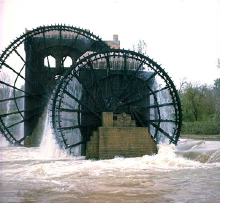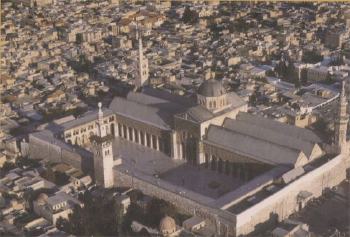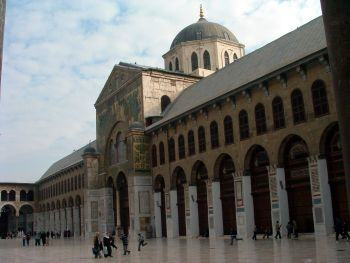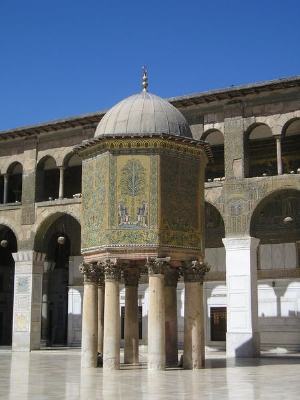 Its inhabitants consider Damascus the oldest permanently inhabited city of the world, but modern archeology now bestows that title on the agricultural market city of Hamah some 200 km north of Damascus.
Its inhabitants consider Damascus the oldest permanently inhabited city of the world, but modern archeology now bestows that title on the agricultural market city of Hamah some 200 km north of Damascus.Capital of Syria and oldest permanently inhabited city of the world.
The first recorded mention of Damascus is known from Egypt, where a record from before 1400 BC mentions Dimashqa in a list of conquered territories. The name of the city (Arabic: Dimashq) is of pre-Semitic origin, which indicates that Damascus was a human settlement before recorded history began (before 3000 BC).
 Its inhabitants consider Damascus the oldest permanently inhabited city of the world, but modern archeology now bestows that title on the agricultural market city of Hamah some 200 km north of Damascus.
Its inhabitants consider Damascus the oldest permanently inhabited city of the world, but modern archeology now bestows that title on the agricultural market city of Hamah some 200 km north of Damascus.
An elaborate irrigation system to support the city existed well before 2000 BC and continued to be augmented over time. The bible mentions Damascus as the capital of the Aramaean empire; remnants of the Aramaic language can be found in names of places and canals of today's Damascus.
Throughout its history Damascus was conquered and ruled. Among the conquerors were
Each occupation brought with it an influx of new settlers, and Aramaean, Greek and Roman quarters existed side by side, each with its own achievements in architecture and art.
At about 34 AD, when Damascus was part of the Roman Empire, Saul of Tarsus (who became known as St. Paul) had a vision on the road to Damascus that told him not carry out his mission to arrest the Christians there. Damascus became an important Christian centre through the activities of St. Paul, and the bishop of Damascus became the second most important figure of the church.
From about 400 AD Syria went through 200 years of much military activity and became the battlefield of the Persian wars. The arrival of the Muslim armies in 635 was therefore greated with much relief, and Damascus opened its gates without resistance. In 661 it became the capital of the Umayyad empire and regained and surpassed its former splendour. The Great Mosque of Damascus, built in 706 -715 and still dominating the city today, is among the jewels of Islamic architecture.

Damascus' role as capital ended in 750, when the Abbasids moved their capital to Baghdad. The cohesion of the city was lost; each ethnic or religious community closed off its quarters with barricades and organized its own public services.
The Seljuq conquest of the city in 1154 ended this period, and once again Damascus became the capital of a large empire. The Seljuqs were followed by the Ayyubids and the Mamluks, who ruled Syria and Egypt between 1250 and 1382. An early occupation and ransacking by Mongols could not do lasting harm, and Damascus grew as a trading centre of food for export and of luxury goods such as brocade, metalworks, glass and ceramics. The ransacking of the city by the Mongols under Tamerlane in 1401 was of more serious consequences, because Tamerlane deported many skilled artesans to his own capital Samarkand.
The strategic position of the city on several important trading routes guaranteed eventual recovery, and after the Ottoman conquest of Syria in 1516 Damascus regained its economical importance.
Ottoman rule was briefly interrupted when Syria came under Egyptian control from 1831 until 1840. Before World War I the Ottomans were confronted by rising Arab nationalism. They evacuated Damascus in 1918, and the city became the capital of an independent Syria. A French invasion in 1920 ended this brief period of independence, and Damascus became the administrative centre of a Syria occupied by France. The occupation ended in 1946, when the modern state of Syria was born.
Today's Damascus, capital of Syria, is a cosmopolitan and lively city of 1.2 million people.
Photos: Hamah water works: public domain (Wikipedia)
View of Damascus and the Great Mosque: check the copyright status.

The courtyard of the Great Mosque
Photo: GNU Free Documentation License (Wikipedia)

The ancient Treasury (Beit al Mal) in the courtyard of the Great Mosque
Photo: GNU Free Documentation License (Wikipedia Commons)